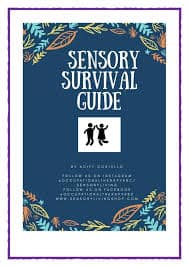Sensory and Self-Regulation Strategies
By Aoife Costello
Occupational Therapist
My name is Aoife Costello and I am a paediatric Occupational therapist (OT). I run the website www.sensorylivingshop.com where I provide a range of therapeutic products for both children and adults. In addition, I work as a private OT providing assessment and intervention for children 0-18 years. I also run the page @occupationaltherapyabc and @sensorylivingshop on Instagram and Facebook.
We are all unique individuals with different sensory preferences and needs. We respond to what we touch, feel, see, hear and how we move in our own unique ways. How we process sensory information (sensory processing) often influences how we self-regulate our emotions and behaviour.
Sensory processing is how we receive and process sensory information so that we can do the things we need to do in our everyday life. For those who have difficulties with processing sensory input, sensory information goes into the brain but does not organise into appropriate responses. Those who struggle with sensory processing perceive and respond to sensations differently than most other people. It is not an impairment e.g. vision/hearing. People do detect sensory information, but the information gets ‘confused’ in the brain leading to inappropriate responses. We need to take in sensory information appropriately to be able to effectively make sense of our environment.
The Eight Sensory Systems Most people are surprised to find out that we actually have eight sensory systems rather than five. • Visual • Auditory • Tactile • Olfactory • Gustatory • Vestibular • Proprioception • Interception
Sensory processing difficulties tend to come in two types, under (hyposensitive) and over (hypersensitive) responsive however it is common for children to experience both e.g. be hypersensitive to one sense and hyposensitive to another.
Others with sensory processing difficulties may:
• Be uncoordinated • Bump into things • Be unable to tell where their limbs are in space • Be hard to engage in conversation or play
Self-regulation is the ability to manage and control our emotions and behaviour. Self-regulation helps us do what we need to do throughout the day.
If you are looking for sensory strategies that can help to calm and regulate children with sensory processing issues you might be interested in my eBook ‘Sensory Survival Guide’ which is full of home and school strategy. The eBook is available worldwide from www.sensorylivingshop.com
A few key tips to help your child regulate at home or at school include the following:
- Quiet den or quiet corner. Having an allocated space for children to feel secure, calm and relaxed is essential, especially if easily stimulated by sensory input. This can just be a corner in the classroom with some soft cushions, possibly a tent or den, fidget toys, soft sensory lights or any other regulatory devices.
- For children that are constantly on the move, enjoy squirming or fidgeting it might be good to look at flexible seating opportunities. For children who seek sensory input, encourage them to sit on a mov n sit cushion, bean bag, peanut ball or any other seating that might give some feedback could make all the difference to their attention and concentration. It might also be worth checking out weighted blankets which provide deep pressure regulating input.
- Fidgets. They can be a real saviour when you get the right that meets your child’s desires. I would recommend using fidgets during transitions especially if your child struggles going to new places or moving from one activity to another. In addition, whilst travelling in the car, have fidgets at hand they can be so calming and regulating!
- Visuals. Another saving grace, visuals can be so useful for transitioning, starting or ending an activity etc. You can use a visual timer, so a countdown timer or visual schedules like a choice board or a first’ then schedule.
- If your child or student is sensitive to loud noises or gets over stimulated easily it could be worth having ear defenders or auditory regulators in the house or classroom.
I recently wrote a collection of eBooks to educate parents and teachers of common Occupational therapy issues that children may have and ways of overcoming these issues.
The eBooks include:
‘Sensory Survival Guide’
‘Fine Motor Skill Activity Guide’
‘Gross Motor Skill Activity Guide’
‘Sensory Trays for All Ages’
Available from www.sensorylivingshop.com

